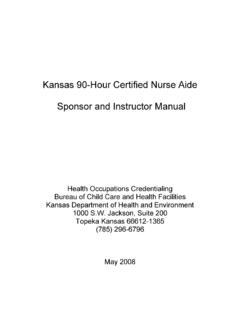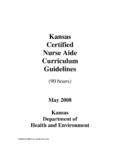Transcription of Psychosocial Needs of the Elderly - kahsa.org
1 Psychosocial Needs of the Elderly Learner's Guide GOAL: You will learn the special Psychosocial Needs of the Elderly and strategies that can be used to help you give person-centered care. You will learn how the use of these strategies can make residents happier and healthier and make them feel better about themselves. It makes the environment of your long-term care community healthier. These strategies can also make your work more pleasant. OBJECTIVES: At the end of this training session, you will be able to: 1. Recognize the developmental stage tasks of the older adult. 2. Identify the common adjustments that happen with aging. 3.
2 State seven myths of aging. 4. Discover strategies that caregivers can use to bring joy to the older adult. 5. Describe how a decline in the five senses impacts the older adult's ability to communicate. 6. Discuss tips for communicating with residents. 7. Differentiate between isolation and solitude. Take Note: You should also review the organization's policies and procedures specific to Psychosocial Needs . Learning Strategies: To complete this lesson, follow these steps: 1. Read the materials provided in each unit of this lesson. 2. Complete the practice exercise or question for each unit. 3. Complete each activity unless instructed otherwise.
3 4. Read the lesson review. 5. Complete the final content assessment. After completing all of these steps, print two copies of the completed activity forms. Give one copy of the completed activity forms to your Education Coordinator and keep one copy for your records. Related Topics: Sensitizing Staff to Growing Old Basic Communication Skills Residents' Rights (September 2007) 1. Kansas Association of Homes and Services for the Aging Introduction: The Elderly population in the United States is growing. In 1900 there were only three million people over the age of 65 in the Now there are more than 34 million. It is estimated that by the year 2020, twenty percent of the population will be older than 65.
4 As scientists and doctors find new ways to cure illnesses, more people are living longer lives. In fact, the fastest-growing age group in the is the 85 years and older group. This group now represents about 40 percent of the Elderly population. Less than 5 percent of the older population is institutionalized at any point in time. However, one in four older adults will spend some of his or her last years of life in a long-term care environment. Changes in the human body can make life more difficult. Often that is why people enter long-term care communities. For some residents, aging is very frightening or depressing. Others adapt well.
5 The way you work with residents can make them feel better about themselves and can make your work more pleasant. Unit 1: Goal: You will learn about the theory of developmental tasks of older adults, seven common Psychosocial adjustments that happen with aging, seven common myths of aging, and strategies to use to assist older adults through these changes and adjustments. Developmental Tasks of the Older Adult Staff that work in long-term care communities have a major role in assisting persons to find satisfaction and a sense of well-being in later life. Staff members need to recognize that their own attitudes toward aging have a great impact on those they care for.
6 Persons who see old age as a progressive decline leading to death may view old age as a depressing, useless period leading to helplessness. However, staff members who view aging as a process in life development can see old age as an opportunity to gain new satisfaction and understanding of themselves and others. This provides joy and a sense of purpose. Which of these two pictures do you hope to become? Several Psychosocial theorists have identified stages and tasks for each age group. Erik Erikson's (1963) work is well known. The stage pertaining to older adults is ego integrity versus despair. The work of this stage is to accept one's life as meaningful.
7 The older person who reaches ego integrity looks back with satisfaction, and has an acceptance of life and death. Death is seen as a part of life. If this stage is not adequately bridged, the person is in a state of despair which is failure to accept the meaningfulness of one's life. When one is in despair, there are feelings of anger, bitterness, depression, inadequacy, failure and fear of death. (September 2007) 2. Kansas Association of Homes and Services for the Aging Robert Peck (1968) identified specific tasks which the older adult must address. Peck stated that the first task is for the older person to develop satisfaction from himself or herself as a person, rather than from an occupational role or as a parent.
8 The second task is to adjust to the physical declines of aging, rather than becoming absorbed in health problems or physical limitations imposed by aging. The third task is to have satisfaction when reflecting on one's past life and accomplishments, rather than dwelling on the prospect of death. Throughout our lifetime, we all face challenges and adjustments in response to life experiences such as coping with losses and change, establishing meaningful roles, exercising independence and control, and finding meaning in life. We find satisfaction in ourselves and our life when we successfully meet these challenges. However, if these tasks are not successfully met, the result is unhappiness, bitterness, and a fear of the future.
9 Common Adjustments Which Occur With Aging Growing old is not easy. Changes which come about as people age demand multiple adjustments. These adjustments demand flexibility and stamina. Here are some changes: Family changes: The family unit is a major source of satisfaction for older adults as they enjoy the love, companionship, and achievement of spouse, children, and grandchildren. Their role within the family has changed multiple times in their lifetime. In old age they are cared for by their children versus the other way around. Retirement: This can be a difficult time because our society places so much emphasis on what a person does.
10 Often one's work gives social position and influence, is a source of social contacts, and provides a feeling of satisfaction from productivity. Awareness of one's own mortality: Not only do spouses die but friends do also. Older adults may also experience health decline. Often, older adults review the significance of their life through reminiscences. They love to tell stories of life events. They need to be encouraged to tell stories. They often are faced with multiple losses at one time. Widowhood: This affects more women than men, as women tend to live longer. Adjusting to the loss of someone you have shared life with is often difficult.

